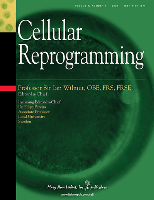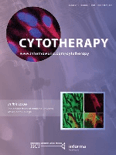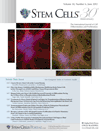
Journal of Stem Cells & Regenerative Medicine
Scope & Guideline
Unlocking the Potential of Stem Cells
Introduction
Aims and Scopes
- Stem Cell Biology and Mechanisms:
Focuses on the fundamental biology of various stem cell types, including their differentiation pathways, signaling mechanisms, and the molecular underpinnings that govern stem cell behavior. - Regenerative Medicine Applications:
Covers research on the therapeutic applications of stem cells in regenerative medicine, including tissue engineering, wound healing, and organ repair. - Cell Therapy Innovations:
Explores advancements in cell therapy techniques, including the use of mesenchymal stem cells (MSCs) and their derivatives for treating various medical conditions. - Extracellular Vesicles and Secretomes:
Investigates the role of stem cell-derived extracellular vesicles and secretomes in mediating therapeutic effects and their potential as cell-free therapies. - Clinical Trials and Safety Studies:
Includes clinical research and trials assessing the safety and efficacy of stem cell therapies, emphasizing translational research from bench to bedside.
Trending and Emerging
- Exosome and Secretome Research:
There is a growing emphasis on the therapeutic potential of exosomes and secretomes derived from stem cells, highlighting their use as cell-free therapies and their role in mediating regenerative effects. - Cancer Stem Cells and Metastasis:
Research on cancer stem cells, particularly their role in tumor metastasis and treatment resistance, is gaining traction, reflecting the need for innovative approaches to cancer therapy. - Personalized Medicine Approaches:
The integration of personalized medicine in stem cell therapies, considering donor characteristics and patient-specific factors, is emerging as a significant theme in recent studies. - Regenerative Strategies for Specific Conditions:
Increasingly, the journal features studies on targeted regenerative strategies for specific conditions, such as osteoarthritis and urethral strictures, showcasing a shift towards tailored therapeutic interventions. - Gut-Brain Axis and Stem Cells:
Research connecting the gut microbiome and gut-brain axis with stem cell therapy is on the rise, indicating an interdisciplinary approach to understanding health and disease.
Declining or Waning
- Traditional Stem Cell Sources:
Research on traditional sources of stem cells, such as embryonic stem cells, has seen a decline in favor of more innovative and ethically acceptable sources, such as induced pluripotent stem cells (iPSCs) and adult-derived stem cells. - Basic Preclinical Studies:
There is a noticeable reduction in purely basic preclinical studies, as the journal increasingly emphasizes translational research that directly connects laboratory findings to clinical applications. - Single Cell Studies:
Research focusing on single cell analysis within stem cell populations is becoming less frequent, possibly due to the rising interest in bulk analysis methods and population-level characteristics. - Non-therapeutic Stem Cell Research:
Interest in non-therapeutic investigations of stem cells, such as purely developmental biology studies without direct clinical implications, appears to be waning.
Similar Journals

Stem Cell Research & Therapy
Unlocking the Potential of Stem Cells for TomorrowStem Cell Research & Therapy is an esteemed international journal published by BMC, specializing in the rapidly advancing fields of stem cell research and regenerative therapies. Since its inception in 2010, the journal has embraced an Open Access model, ensuring that vital research is readily accessible to a global audience. With a significant impact in the scientific community, it holds Q1 quartile rankings in prestigious categories such as Biochemistry, Genetics and Molecular Biology, Cell Biology, and Molecular Medicine, highlighting its critical role in promoting groundbreaking research. The journal’s high Scopus rankings—placing it in the top echelons of its fields—reflect its commitment to publishing high-quality, peer-reviewed studies that advance our understanding of stem cell biology and therapeutic applications. Aimed at researchers, healthcare professionals, and students alike, Stem Cell Research & Therapy is an indispensable resource for those dedicated to the exploration and innovation within this transformative area of science.

Cellular Reprogramming
Connecting Scientists to Shape Regenerative MedicineCellular Reprogramming is a prominent academic journal published by MARY ANN LIEBERT, INC, dedicated to advancing the field of cellular biology and biotechnology. With its ISSN 2152-4971 and E-ISSN 2152-4998, this journal provides an innovative platform for researchers and professionals to share groundbreaking research findings on cellular reprogramming, stem cell biology, and regenerative medicine. Established in 2010, and actively publishing until 2024, the journal is recognized for its contributions, evidenced by its categorizations in the Q3 and Q4 quartiles across several related fields, including biotechnology and developmental biology. This peer-reviewed journal not only supports open access to scientific literature but also aims to enhance interdisciplinary collaboration among scientists. With a growing impact in the realms of biochemistry, genetics, and molecular biology, Cellular Reprogramming remains an essential resource for the dissemination of pioneering research that could shape the future of cellular therapies.

Inflammation and Regeneration
Leading the charge in open-access immunology and regenerative research.Inflammation and Regeneration is a prominent open-access journal published by BMC, focused on the discerning fields of immunology, cell biology, and regenerative medicine. Since its establishment in 2016, the journal has provided a platform for the dissemination of high-quality research, contributing significantly to the advancement of knowledge in inflammation processes and regenerative therapies. With a remarkable impact reflected in its Q1 quartile rankings in Cell Biology and Immunology for 2023, Inflammation and Regeneration stands out as a leading resource for researchers and practitioners. The journal's commitment to open access ensures that critical findings are readily available to a global audience, fostering collaboration and innovation in the scientific community. With a Scopus ranking that places it in the top 20% of its categories, Inflammation and Regeneration serves as an essential reference for those seeking to stay at the forefront of immunological research and its applications.

Stem Cells Translational Medicine
Exploring New Frontiers in Translational MedicineStem Cells Translational Medicine, published by Oxford University Press, is a leading open-access journal that has been at the forefront of stem cell research since its launch in 2012. With an impressive impact across various categories, it occupies Q2 in Cell Biology and is highly recognized in Q1 for both Developmental Biology and Miscellaneous Medicine in 2023. Its strong Scopus rankings highlight its significance in the fields of Biochemistry, Genetics, and Molecular Biology, achieving an outstanding percentile ranking of 93rd in Developmental Biology. The journal provides a pivotal platform for researchers, professionals, and students to publish and access cutting-edge findings that contribute to the understanding and application of stem cell technology. With a commitment to disseminating high-quality scientific knowledge, Stem Cells Translational Medicine plays a vital role in advancing research and innovation within the rapidly evolving landscape of regenerative medicine.

BIOCELL
Pioneering Discoveries in Molecular BiologyBIOCELL is a distinguished peer-reviewed journal dedicated to the field of Cell Biology, published by TECH SCIENCE PRESS. Since its inception in 1995, the journal has been at the forefront of disseminating innovative research, with converged publication years extending from 1995 to 2013 and from 2015 to 2024. Although it currently holds a Q4 ranking in the Cell Biology category according to the 2023 category quartiles, BIOCELL aims to foster advancements by providing a platform for researchers, professionals, and students to share their findings in biochemistry, genetics, and molecular biology. The journal is available in both print (ISSN: 0327-9545) and digital formats (E-ISSN: 1667-5746) and seeks to attract contributions that enhance scholarly dialogue and understandings of cellular mechanisms and innovations. With a commitment to quality research and critical discourse, BIOCELL plays an important role in nurturing the scientific community within Argentina and beyond, offering vital insights that contribute to the advancement of the life sciences.

CYTOTHERAPY
Elevating Research in Cell Therapy and Transplantation.CYTOTHERAPY is a distinguished journal published by Elsevier Science Ltd, focusing on the critical fields of cell therapy, transplantation, and regenerative medicine. Since its inception in 1999, the journal has established itself as a vital resource for researchers and practitioners, contributing significantly to advancements in Cancer Research, Cell Biology, Genetics, Immunology, and Oncology. With an impressive range of Q2 rankings across multiple categories and a remarkable Q1 standing in Transplantation for 2023, CYTOTHERAPY delivers high-impact research that addresses the evolving challenges in these fields. While the journal does not offer open access, it remains a reputable avenue for disseminating pivotal studies and reviews that push the boundaries of cell-based therapies. Researchers, clinicians, and students alike will find CYTOTHERAPY an indispensable platform to stay abreast of the latest discoveries and innovations that are shaping the future of medical science.

STEM CELLS
Unveiling the potential of stem cell science.STEM CELLS, published by Oxford University Press, is a leading academic journal dedicated to advancing the field of cell and developmental biology. With an impressive impact factor and ranking in the Q1 and Q2 quartiles across various disciplines, including Developmental Biology and Molecular Medicine, this journal serves as a critical platform for disseminating cutting-edge research findings from 1981 to the present. The journal's rigorous peer-review process ensures the highest quality of published content, making it an essential resource for researchers, healthcare professionals, and students interested in the latest breakthroughs in stem cell research and its applications. With a focus on innovative methodologies and holistic perspectives, STEM CELLS not only highlights significant discoveries but also fosters a collaborative exchange of ideas, driving forward the frontiers of science in regenerative medicine and developmental studies.

Cell Journal
Shaping the Future of Cell Science Through InnovationCell Journal is a leading interdisciplinary publication in the fields of Cell Biology, Developmental Biology, Molecular Biology, and Reproductive Medicine, published by ROYAN INST since its inception as an open-access journal in 2007. With an ISSN of 2228-5806 for print and 2228-5814 for electronic editions, it provides a vital platform for researchers and professionals to disseminate innovative findings and insights that shape our understanding of cellular processes and reproductive sciences. The journal boasts an impressive Scopus ranking, achieving a Q3 position in both Molecular Biology and Reproductive Medicine, highlighting its significance in the academic community. Situated in Tehran, Iran, Cell Journal encourages global collaboration through its accessible content, making cutting-edge research available to a diverse audience. As it converges from 2011 to 2024, the journal continues to emphasize the importance of thorough scientific inquiry, fostering advancements that drive both theoretical frameworks and practical applications in cell science.

STEM CELLS AND DEVELOPMENT
Empowering the Future of Regenerative MedicineSTEM CELLS AND DEVELOPMENT, published by Mary Ann Liebert, Inc., is a leading peer-reviewed journal dedicated to the rapidly advancing fields of stem cell biology and developmental science. With an ISSN of 1547-3287 and an E-ISSN of 1557-8534, the journal encompasses a broad range of topics central to understanding stem cells' roles in development and regeneration processes. It holds a prestigious standing within its category quartiles, ranking Q3 in Cell Biology, Q2 in Developmental Biology, and Q2 in Hematology for 2023. With its convergence from 2004 to 2024, STEM CELLS AND DEVELOPMENT fosters an innovative platform for researchers, professionals, and students to disseminate groundbreaking research, share insights, and explore novel therapeutic approaches. Open access options enhance the journal's visibility and accessibility, promoting a collaborative exchange of information among the scientific community. Positioned at the forefront of stem cell research and its applications, this journal is vital for anyone seeking to stay informed about the latest advancements and trends within these critical areas of study.

Regenerative Therapy
Elevating the discourse on regenerative therapies worldwide.Regenerative Therapy is a premier open-access journal dedicated to advancing the fields of biomaterials, biomedical engineering, and developmental biology. Published by Elsevier in Japan, this journal has been an influential platform since its inception in 2015, contributing significantly to the global discourse on regenerative medicine. With an impressive Q2 ranking in major categories such as Biomaterials and Biomedical Engineering, it is recognized for its quality of research and innovation. Researchers seeking to disseminate their findings or explore cutting-edge developments will find Regenerative Therapy to be invaluable, reflecting current trends and fostering collaborations across interdisciplinary boundaries. The journal offers open access, ensuring that high-quality research is available to a broad audience and enhances the impact of scholarly work in the regenerative medicine community.